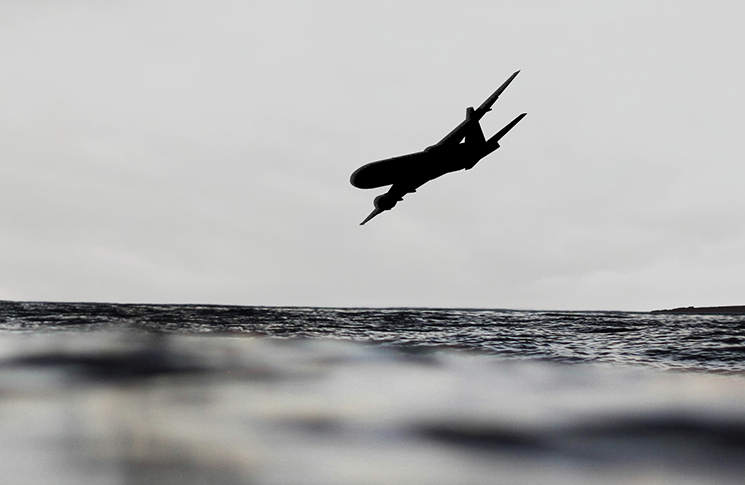In a few seconds, an IFR departure in stormy weather went flamboyantly out of control. A simple but pernicious combination of factors overcame an experienced crew and nearly killed 281 people.
It was a dark and stormy afternoon and at 19 degrees, not the sort of weather that attracts sun-seekers to Hawaii: a good time to fly home. At 1432 local time on 18 December 2022, United Airlines flight UA1722, a Boeing 777-200, pushed back from its berth at Kahului Airport on the island of Maui, for a flight to San Francisco.
Before arrival at the airport, the captain had held a thorough briefing with the flight dispatcher about the weather that afternoon. They agreed to an alternative departure route that would lessen the need for weather deviations during climb and initial level off. The purser on the 777’s arriving flight mentioned how rough the descent into Maui had been and the captain emphasised the importance of cabin crew remaining seated and strapped in on the planned departure.
During their pre-flight meeting, the first officer mentioned an incident earlier that morning involving a Hawaiian Airlines flight that had experienced what appeared to be severe turbulence on descent. The event was already ‘on the grapevine’ as the first officer had received a text about it. The flight crew concluded additional vigilance would be needed on this take-off.
Events seemed to confirm this judgement. During pushback from the gate, the tower reported winds shifting from 030 to 190. The ATIS was inoperative and the first officer used a phone to receive current weather.
Take-off setting was flaps 20 with a reduced thrust setting, which the captain accepted as there was only a light crosswind. The captain and first officer briefed themselves on windshear warning and precautions. But as they waited in the queue for take-off, they heard several low-level wind shear advisories from preceding departures. The captain decided to use full thrust and briefed the first officer of this decision. Again, they reviewed windshear procedures.
I announced ‘pull up, pull up, pull up, pull up’ many times as the GPWS enunciated.
After a hold of 3 minutes after the preceding aircraft, the take-off roll began at 1449, with windscreen wipers on high. Rotation and initial climb were normal, but the aircraft soon began to encounter rapid airspeed fluctuations in light turbulence that became moderate at higher levels. The captain was hand flying, with autothrottles engaged.
After 45 seconds, the flight reached an altitude of 1,500 feet and the captain eased the yoke forward to reduce pitch, simultaneously calling for flaps 5. At this point recollections diverged, but their themes were consistent: the crew became flummoxed and in those few seconds the aircraft went into imminent danger.
The captain told the US National Transportation Safety Board (NTSB):
I called for flaps 5 and noticed VMO/MMO [velocity maximum operating/mach maximum operating] moved opposite to my expectation (towards the speed bug instead of a higher speed). Airspeed began to accelerate rapidly and, based on the rate of increase, I anticipated a flap overspeed. I reduced the power manually (overriding the autothrottle servos) but not enough to incur a reversal in IVSI [instantaneous vertical speed indicator] towards a descent. We were still [in] a positive climb.
The reduction in power was to reduce the extent of the flap overspeed and slow the airspeed acceleration trend. We ended up over speeding the flaps by approximately 10–15 knots as I recall. My next course of action was to quickly find out the status of the flaps and if there was a mechanical failure. I glanced over to the flap indicator and noticed the flaps were at 15 instead of 5 as I had asked for.
I would note that the selection of retracting the flaps from 20 to 5 is a normal and acceptable line operation procedure and in my experience the most common; however, to the best of my knowledge, there are no flight manual restrictions on retracting the flaps from 20 to 15.
There were no EICAS [engine indicating and crew alerting system] messages or chimes noted at that time. I immediately called again for flaps 5 and repeated the call at least once more. I saw the F/O’s hand move towards the flap handle and made the selection.
The first officer remembered a subtly different sequence of events in a statement to the NTSB:
I heard the captain announce ‘flaps 15’ as Maui Tower switched us to HCF [Honolulu control facility] Departure. I selected flaps 15 and checked in with HCF Departure climbing through 1,400 feet and into IMC. HCF responded, ‘Climb and maintain 16,000 feet’ … I noticed our airspeed holding just below max VFE, 178 knots, selected WXR [weather radar] on the EFIS control panel and then adjusted the altitude in the altitude window on the MCP [mode control panel]. At this point we were climbing through 2,000 feet and I noticed our pitch slowly decreasing but still maintaining a positive pitch angle.
Automatic dependent surveillance-broadcast (ADS-B) data showed the aircraft’s lowest altitude was 748 feet.
The following happened within 10–15 seconds. The captain announced, ‘flaps 5’ and I heard ‘don’t sink’ at the same time. The pitch angle decreased further towards a 00-pitch angle and our airspeed increased rapidly through the current VFE limit.
At this point I knew the captain was having difficulty with airspeed control and I noticed our pitch turn to a negative pitch angle. I queried the captain on what was happening. I couldn’t be certain what the captain was dealing with, since I saw no windshear indications and heard no immediate response from the captain after my query. I wasn’t sure if there was an instrumentation error on my flight instrument displays and was confused about how he was responding to the increase in airspeed and the aircraft pitch attitude.
Very shortly after calling ‘flaps 5’, the captain announced ‘flaps 1’. I selected flaps 1 and noticed our airspeed continue to increase as the yoke moved forward, pitching the nose down and the thrust stayed at a climb power setting with the captain overriding the thrust levers slightly.
I glanced over to crosscheck the captain’s primary flight display and his handling. Instantly after looking over, I sensed cloud movement out the forward window, indicating a cloud breakout. I instantly recognised the severity of our situation, looked down and noticed our airspeed 20–30 knots past the VFE limit, with the altimeter falling, and the pitch around -8 degrees to -10 degrees nose down. I announced ‘pull up, pull up, pull up, pull up’ many times as the GPWS enunciated.
The captain then brought the yoke aft, increasing our pitch angle, pulled the thrust to idle, then as the aircraft began a positive pitch trend, the captain then increased thrust to maximum and called ‘flaps up’, performing an escape manoeuvre.
In the same moment, I checked the speed brakes and heard ‘TERRAIN, TERRAIN, PULL UP, PULL UP’ as our descent stopped and reversed trend around 800 feet on the radar altimeter. Our pitch increased to over 20 degrees nose up and our airspeed trend reversed and then held at around 230 knots as our VFE limit went to the flaps up normal limit.
Automatic dependent surveillance-broadcast (ADS-B) data showed the aircraft’s lowest altitude was 748 feet. Its maximum descent rate of 8,536 fpm, recorded at 1,386 feet, would have put it into the sea in under 10 seconds had the crew not recovered. This manoeuvre produced a force of 2.77 G in the cabin, causing consternation.
‘The plane dipped down, like a sudden drop, and then quickly went back up,’ a passenger told an aviation website. ‘Several people screamed, but it was over quickly, no-one was injured and the rest of the flight was uneventful. My husband thought we were getting close to the water, but we didn’t realise it was this close.’
After assessing there was no damage or injury, the crew continued to San Francisco, where engineers, alerted by the aircraft’s reporting system, inspected the flaps. By that night, a different crew had flown the aircraft on a normal service to Chicago.

Analysis
In the crew debrief that happened once the aircraft had cleared several storm cells and climbed to cruising altitude, it became clear there had been a miscommunication. Flaps 15 had been selected instead of flaps 5. James Reason categorises this mis-selection error as a ‘slip’, where an action that was intended to be performed was not carried out. Slips are abundant evidence of the 18th century poet Alexander Pope’s declaration, ‘to err is human.’ From time to time, they are made by all of us, including highly qualified professionals of vast experience.
The ADS-B record showed the descent had occurred after the retraction of the flaps. The first officer noticed the captain putting forward input into the yoke, but the captain had no recollection of doing so. There is a reasonable explanation for this: somatogravic illusion, a form of spatial disorientation. Although not mentioned in the NTSB’s brief report, it is possible the pilot’s inner ear mechanism interpreted the aircraft’s acceleration as a pitch-up, to which the instinctive reaction would have been to lower the nose. Pilots are trained to recognise and resist somatogravic illusion but it can sneakily reassert itself in moments of stress and confusion.
It is also conceivable a downdraft or windshear could have initiated or intensified the descent but neither pilot remembered the aircraft’s warning systems making any such announcement.
Media outlets, including respected mastheads that should have known better, declared the incident had been a result of ‘pilot error’. This is, at best, only part of the story. Despite the confusion that overtook them, the crew reacted swiftly and in textbook manner. The aircraft’s systems also performed as designed to alert the crew to the situation.
In the early years of the jet age, similar crashes routinely killed hundreds of people. One example is South African Airways flight 228, which crashed after take-off from Windhoek, Namibia on the night of 20 April 1968 in what, despite the aircraft’s lack of flight recorders, was determined to be a controlled flight into terrain after flaps had been raised at low altitude.
More serious was the organisational failing that led to the NTSB being unaware of the incident near Hawaii for 2 months, despite the crew having reported it to United Airlines and the airline reporting it to the Federal Aviation Administration. The incident was not reported to the NSTB because it did not meet the requirements of Title 49 Code of Federal Regulations Part 830.5. As no damage or injury occurred, it slipped under the organisational radar. However, the story broke on the internet where aviation bloggers noticed the alarming flight path recorded by ADS-B and publicly available on flight tracking websites. The NTSB opened an investigation in early 2023. By then the aircraft’s cockpit voice recorder and flight data recorder were long since overridden.
The story of flight UA1722 is about things that went right, as well as things that went wrong. Briefing, a drilled recovery procedure and crew resource management that allowed communications to recover between the pilots, played a part in keeping the aircraft out of the sea. The flight crew’s prompt debrief established a reasonably accurate record of the event, before the inevitable distortions of delayed recall. There was no disaster, but this should be cause for reflection, not smugness. 
For more information read the report on the NTSB website.





